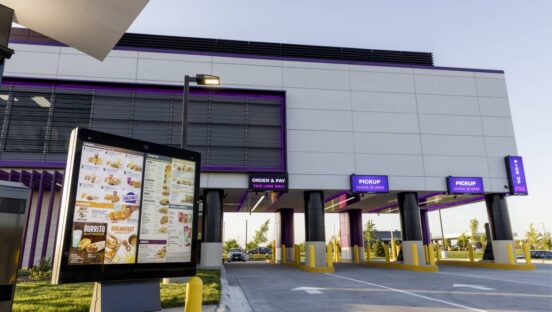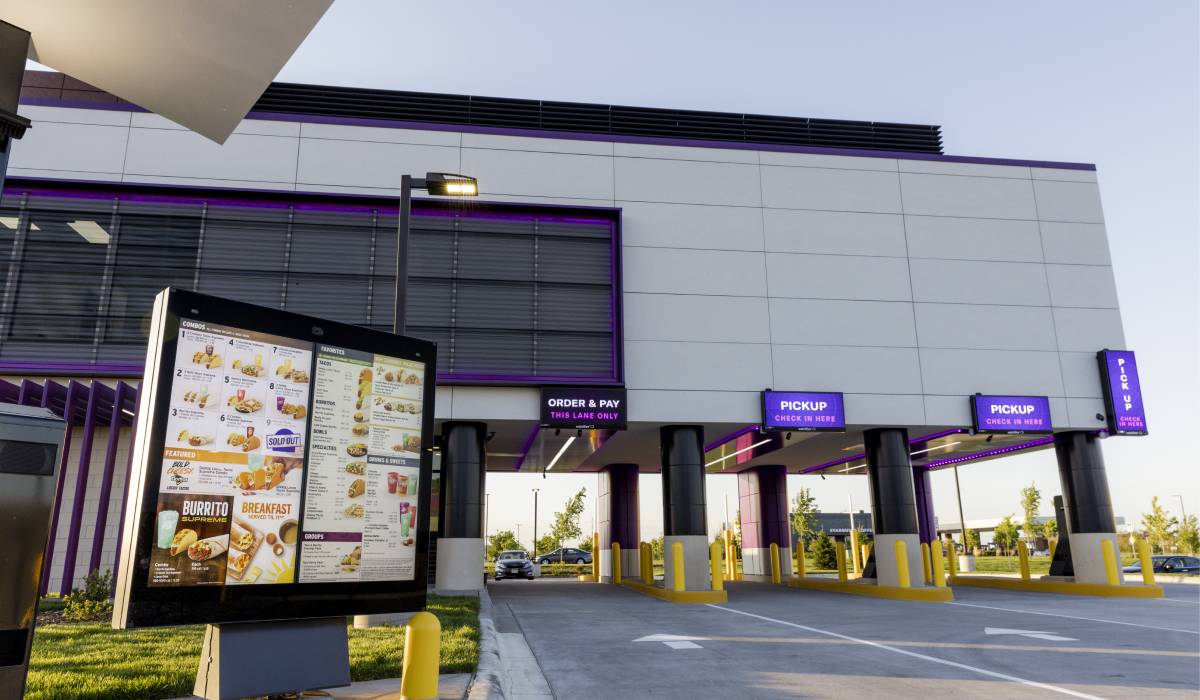When the pandemic made social distancing a necessity, drive-thrus saw a considerable uptick in traffic. Restaurants needed to serve not only traditional drive-thru orders placed at a speaker and picked up at a window, but also guests arriving to pick up their online orders for takeout, as well as third-party delivery drivers picking up delivery orders. If crunch time in the drive-thru was like a rush hour traffic jam before, the pandemic turned it into gridlock.
Avoiding Gridlock
Restaurants have tried various tactics to speed snaking lines of guests through the drive-thru while avoiding drive-offs. Some send crew members through the line to take guest orders on a handheld device while signage directs delivery drivers and takeout customers to holding spots to wait for their order, for a service model that is ‘drive-thru/curbside hybrid.’ Other brands have tried new drive-thru configurations or multiple lanes to handle the various types of off-premises service.
Clearly, anything that involves construction or remodeling requires significant capital expenditure and can cause service disruption. And with some brands seeing 60–70 percent of their business come through the drive-thru, who can afford to close it even for a day?
Let’s take a look at a few of the lower-cost, practical improvements and changes that a restaurant can make that give awesome results including the convenience, speed, and accuracy that guests want.
Convenience—Guests adopted the drive-thru out of necessity when the pandemic closed dining rooms, but they seem to be staying in the drive-thru if brands make it convenient. Some guests still prefer to avoid contact with other guests and employees, and staying in their car helps them feel safe. As restaurants continue to refine their methods for serving all types of takeout / off-premises orders, they are discovering technologies that help move traffic quickly. Guests appreciate the attention to convenience. But so do third-party delivery services and drivers, for whom time is money.
What might a delightful, convenient food pickup experience in a quick-serve drive-thru look like?
It streamlines communication. Gone are the days of pulling into a parking stall and scanning a QR code or texting or calling a number to let the crew know you have arrived to pick up your order. New curbside solutions are using geofencing to sense when a guest enters the lot and seamlessly notifies the customer where they should go once they arrive. On a dashboard inside the restaurant, staff can see and interact with orders as they come in, in real-time, and see arrival notifications based on continuous GPS tracking.
Restaurants can access consoles on various devices to interact with and manage orders as they are placed, fired, and delivered. They can also customize notifications and customer arrival lead time.
Speed—During the pandemic, average wait times and service speed in most drive-thrus increased. Between 2020 and 2021, over the course of about one year, the average total time spent in the drive-thru lane increased by more than 25 seconds to 382 seconds. This, despite operators’ best efforts, including making innovative operational changes and optimizing drive-thru menu options for speed.
Forward-thinking restaurants recognize that persistent guest habits and ongoing staff shortages require long-term changes that can sustain service levels. Some have announced or are piloting completely new concepts focusing more on off-premises; others have announced reimagined drive-thrus. Some, like Taco Bell, are pursuing both.
One way that some operators are pushing on the accelerator of drive-thru service times is by incentivizing their drive-thru crews to improve speed of service. How? Gamification. Timer systems that use friendly, fun competition between restaurants can boost service speed. These solutions rank competing crews, displayed on a crew-facing screen. Seeing their team’s standing ranked against other teams prompts staff to work together and serve guests swiftly. When crews compete and own their success, everyone wins—guests, employees, individual restaurants, and the brand.
With employee satisfaction being an essential aspect of employee retention, offering a fun and engaging ‘gamified’ work environment can boost employee happiness and encourage people to stick around longer.
Accuracy—Anyone who has opened their food container after driving away only to find a mistake in their order has experienced the frustration that restaurants try to avoid. It goes without saying that guests highly value accuracy in the drive-thru, and good two-way communication is critical to ensuring accurate orders. Customer-facing order confirmation screens are one aspect of the accuracy solution. Restaurants need to remove whatever obstacles prevent accurate service. Good verbal communication—whether among its crew or between crew and customer—is still essential to getting a guest’s order right. Having a good headset solution for drive-thru can help brands improve the accuracy quotient by offering clear, crisp sound quality. These modern systems can increase service speed with dual-lane capability, a built-in greeter with 16 pre-recorded messages, and order-taking modes.
As a sector, we are at the tipping point for new solutions that not only speed up drive-thru times, but also elevate the experience for our guests. Only time will tell how “smart” drive-thru tech will get, but one thing is certain, it is crunch time for those brands looking to evolve and adapt in the age of the drive-thru.
Brittany Maroney is an 18-year veteran of the restaurant industry, where she has spent her career growing concepts and driving brand loyalists. As the director of marketing and communications for the premier loyalty software solution Punchh, as well as for PAR technology, Maroney brings unique insight into the challenges and opportunities of restaurateurs across the nation.








